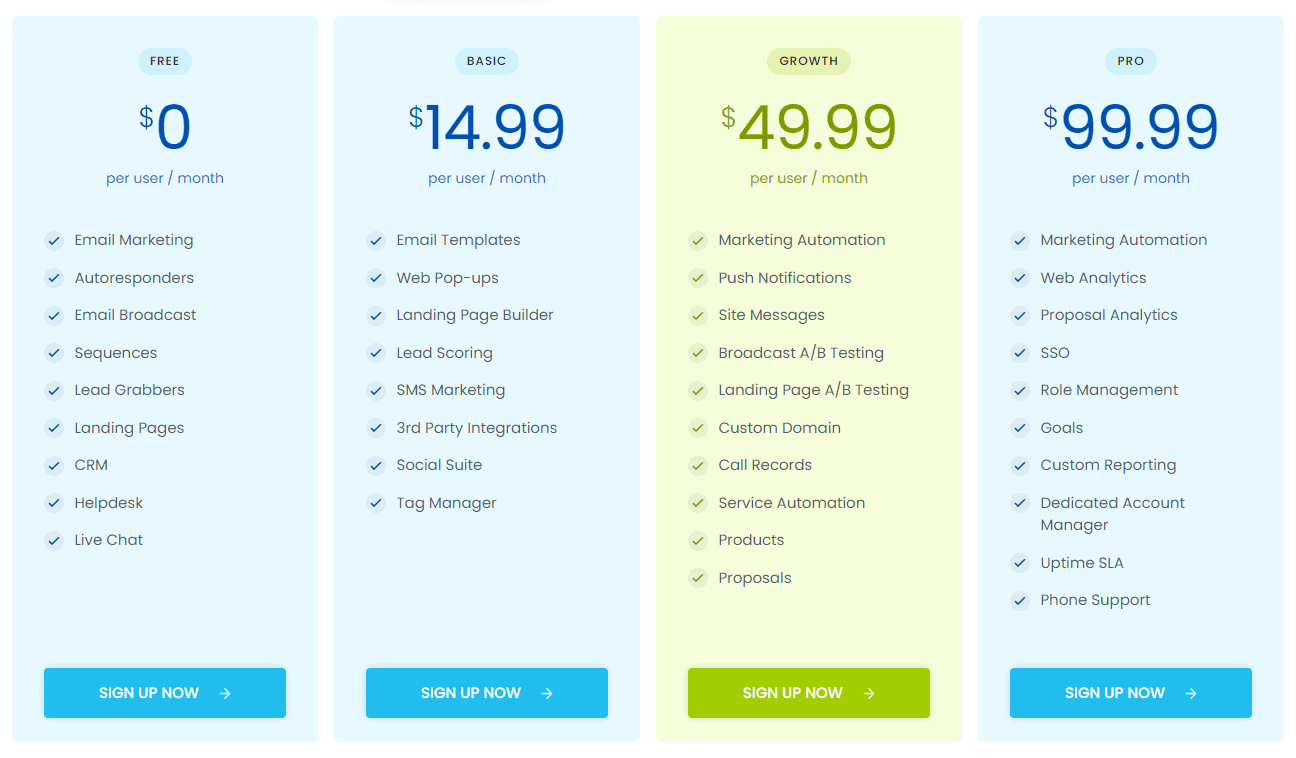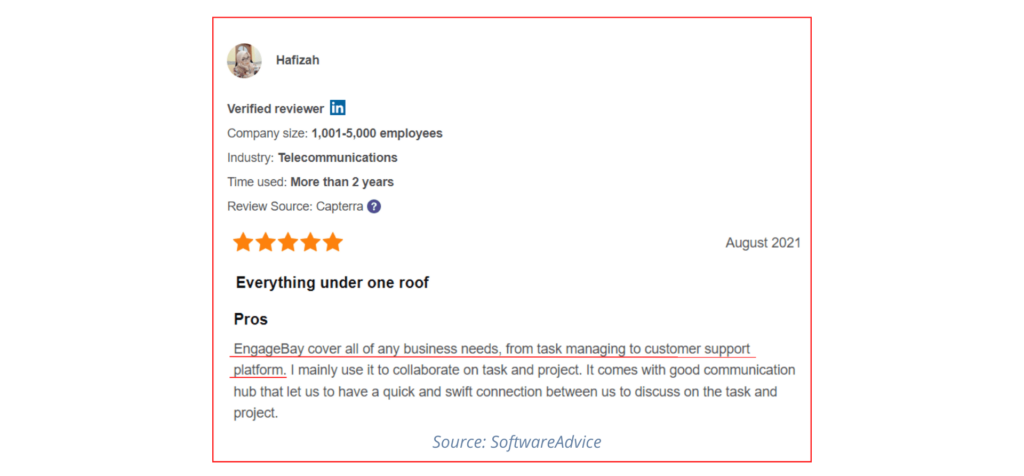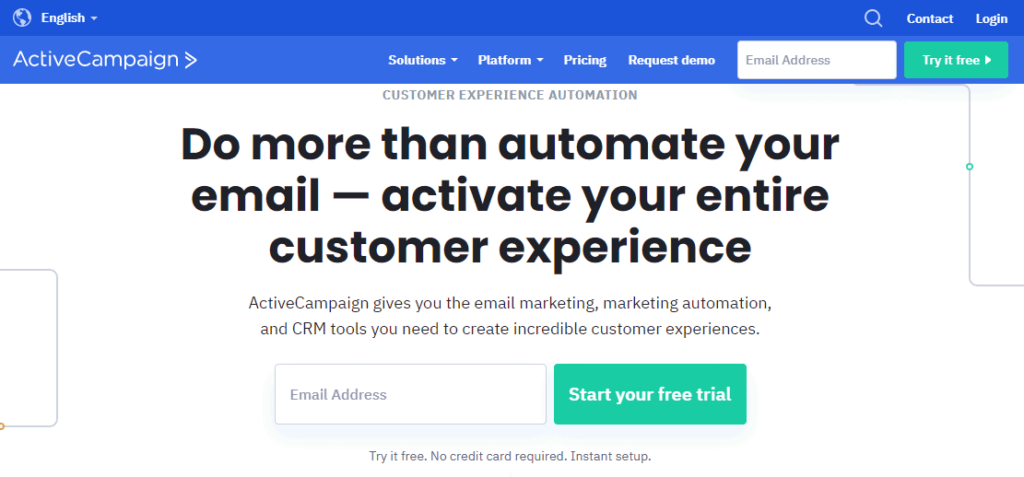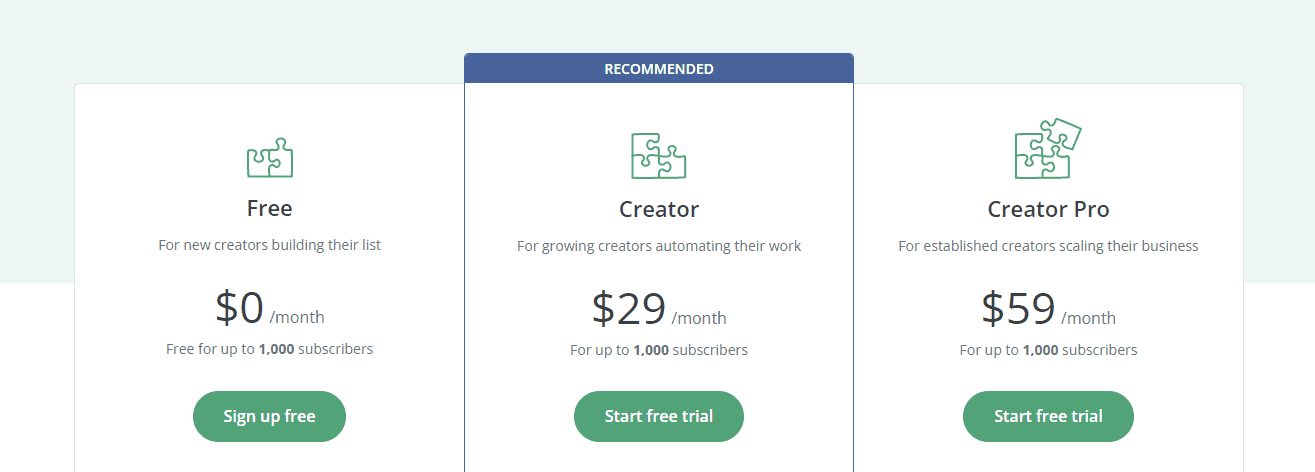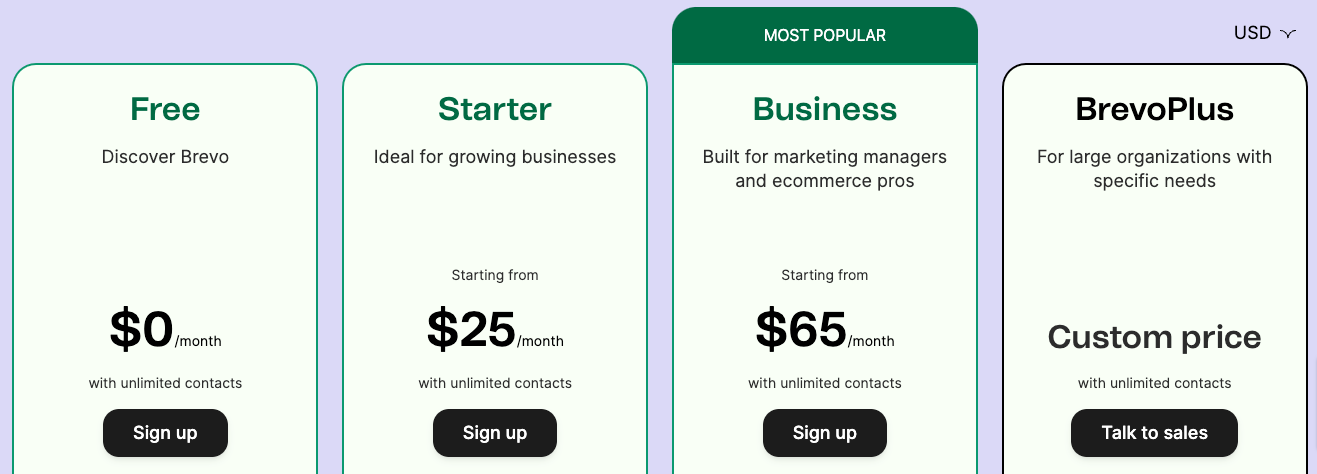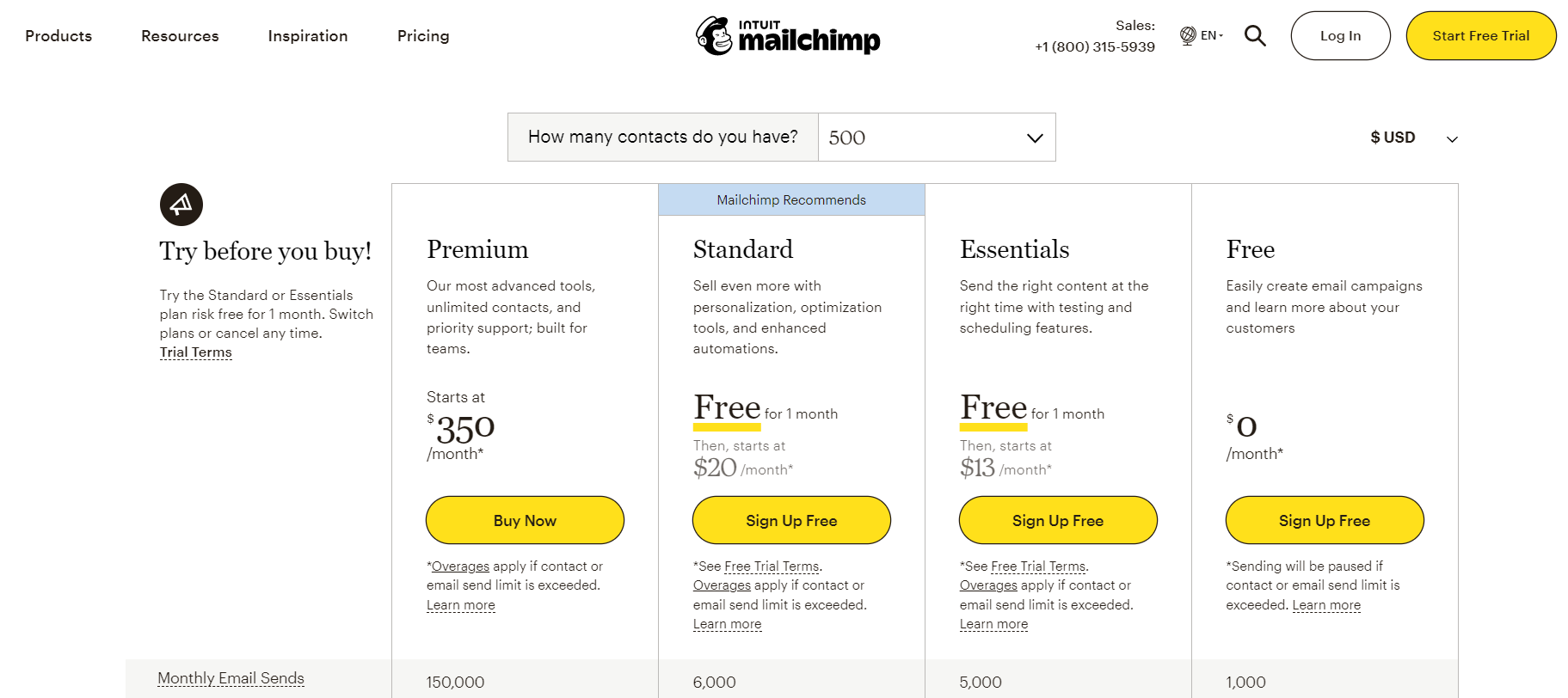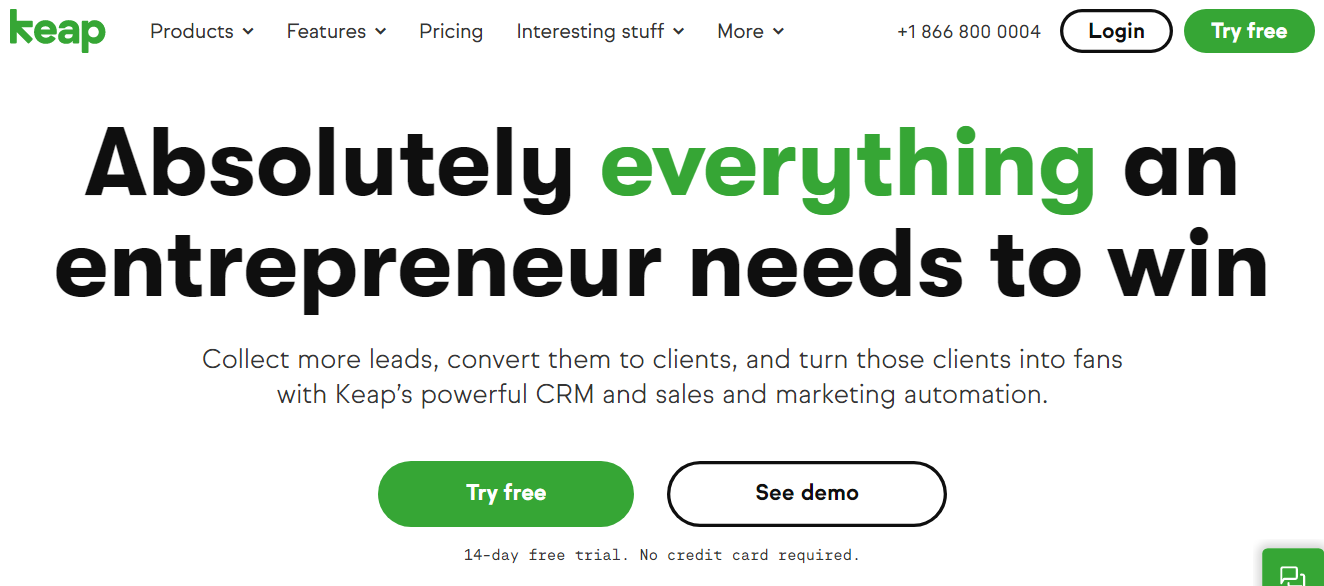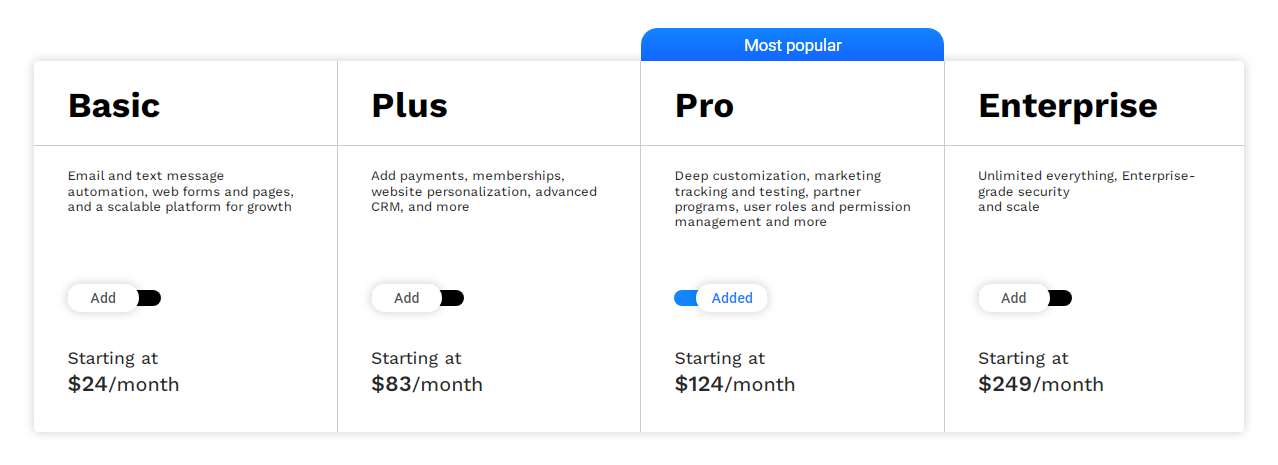Are you looking for the perfect email marketing platform for your growing business? Maybe you’re tired of expensive software that do not offer a comprehensive set of tools. GetResponse — though an excellent email marketing platform — does not offer comprehensive sales and customer support features.
Think about that for a minute.
According to HubSpot, 93% of customers will likely make repeat purchases with companies that offer excellent customer service.
Fortunately, some of the best GetResponse alternatives offer a complete suite of marketing, sales, and customer support tools, eliminating the need for multiple systems. This, in turn, reduces data inconsistencies.
Let’s get started.
Table of Contents
An Overview of GetResponse
GetResponse is a great email marketing software that offers many tools to help businesses create and automate content, enhance sales figures, and drive web traffic.
Brands and businesses of all shapes and sizes use GetResponse for their marketing and sales needs.
GetResponse has powerful features, including landing page builders, customer relationship management (CRM) software, email marketing integration, and more. These are indispensable tools for launching and managing effective marketing campaigns.
With this suite of tools, you can interact with your prospects, leads, and clients in a personalized way, thus building strong customer relationships.
GetResponse Pricing
The platform has five plans: Free, Basic, Plus, Professional, and Max.
- Free: Free-forever, with 2,500 newsletters, a website builder, 500 contacts, and more.
- Basic: Starts at $19/month, with features like sales funnels, email marketing, and autoresponders.
- Plus: The most popular plan, starting at $59/month for 1,000 contacts.
- Professional: Costs $119/month a month for 1,000 contacts.
- Max: Starts at $999/month for custom solutions, dedicated infrastructure, and more.
Read also: GetResponse Pricing — A Comparison with More Inexpensive Alternatives
Why Do You Need a GetResponse Alternative for Email Marketing Automation?
GetResponse has its shortcomings. The basic plan has limited email marketing features that might only suit some businesses.
There are other hiccups, too.
GetResponse’s forms aren’t very responsive, and their templates look outdated. Many users also faced issues while importing lists:
But more importantly, GetResponse is not an all-in-one marketing, sales, and customer support software. Without this, there’s no way to track and manage your customers across all touchpoints.
15 GetResponse Alternatives that Offer Better Value
That’s why we’ve compiled fifteen of the best GetResponse alternatives, ranging from the most affordable to the most feature-packed.
All these GetResponse competitors offer excellent value.
| GetResponse alternative | Starting price | Free plan? | G2 rating |
| EngageBay | 14.99/month | ✔ | 4.6/5 |
| ActiveCampaign | $15/month | ⛌ | 4.5/5 |
| ConvertKit | $29/month | ✔ | 4.4/5 |
| Brevo (Sendinblue) | $25/month | ✔ | 4.5/5 |
| AWeber | $12.50/month | ✔ | 4.2/5 |
| Mailchimp | $13/month | ✔ | 4.3/5 |
| Constant Contact | $12/month | ⛌ | 4.0/5 |
| Campaign Monitor | $11/month | ⛌ | 4.1/5 |
| Drip | $39/month | ⛌ | 4.4/5 |
| HubSpot | $18/month | ✔ | 4.4/5 |
| Keap | $199/month | ⛌ | 4.2/5 |
| Ontraport | $24/month | ⛌ | 4.5/5 |
| MailerLite | $10/month | ✔ | 4.6/5 |
| Omnisend | $115/month | ✔ | 4.5/5 |
| Moosend | $9/month | ⛌ | 4.7/5 |
#1. EngageBay
The first pick from our list of GetResponse alternatives is EngageBay.
EngageBay is the best GetResponse alternative for small businesses and startups looking for an affordable yet comprehensive marketing and sales package.
EngageBay offers four services: All-in-One Suite, CRM & Sales, Marketing, and Service.
EngageBay best features
Here are some fantastic features of EngageBay:
- Marketing automation: You can completely automate your SMS or email marketing campaigns using email sequences, scheduling, follow-up emails, and even automatic welcome emails. EngageBay also offers omnichannel marketing: you can engage with your audience through email, phone, SMS, social media, landing pages, and web push notifications.
- Video templates: With EngageBay’s powerful video marketing templates, you can attract your customer’s attention by creating customized video thumbnails. Embedding custom thumbnails into your emails has never been easier.
- Sales Bay: With state-of-the-art CRM Telephony software, you can target personalized offers to your leads by tracking both the context and content of your conversations. EngageBay’s appointment scheduling tool increases efficiency and brand perception by allowing your clients to choose suitable meeting times.
- Service Bay: The Service bay allows you to provide customer support tickets, track problems, and solve queries. You can also automate the ticketing system, generate canned responses, and create support groups.
- LiveChat Bay: With this feature, you can interact with your customers in real-time. You can also pre-design live solutions to FAQs, thus improving efficiency.
EngageBay pricing
Let’s talk about pricing.
EngageBay has one of the most tailored pricing structures of all the alternatives.
With its modular and tiered pricing structure, businesses can choose a product that perfectly fits their needs.
Pricing for the All-in-One Suite:
- Free: You can store up to 500 contacts and send 1,000 emails a month with this plan. You get features like helpdesk, CRM, sequences, social media management, autoresponders, email marketing, and live chat. This makes EngageBay the best alternative to GetResponse for small businesses.
- Basic: You can have up to 1,000 contacts and send 3,000 emails monthly. You get all the Free plan features plus email templates, a social suite, lead scoring, and a conversational inbox. Pricing starts at $14.99/month/user.
- Growth: You can store 10,000 contacts and send 25,000 emails per month in this plan. In addition to the Basic plan features, you get A/B testing, push notifications, proposals, and custom domains. The Growth plan costs $49.99/month/user.
- Pro: With the Pro plan, you can have unlimited contacts and send up to 50,000 emails. This is the most comprehensive and feature-rich package, with tools like uptime SLA, SSO, custom reporting, and more. The plan starts at $99.99/month/user.
Here’s an explainer video:
EngageBay pros and cons
Find out if EngageBay is the right fit for your business.
Pros
- Best value for your money as an all-in-one solution.
- Powerful automation with drag-and-drop editor.
- Integrated software eliminates the need to purchase additional software.
- Free CRM, onboarding sessions, and migration.
Cons
- Fewer third-party integrations, but EngageBay is rapidly closing the gap.
- No dedicated search engine optimization.
Read also: What is Sales Velocity and How Do You Measure this Metric?
#2. ActiveCampaign
ActiveCampaign is a marketing automation tool that includes CRM and email marketing.
With a vast customer base, ActiveCampaign is recognized for quality sales, marketing, and service tools.
The platform has advanced features and even machine learning that caters to complex automation.
ActiveCampaign best features
- Machine learning: Machine learning is one of the most touted features of this platform. You can boost sales using machine learning to predict your customer’s preferences and send emails at the right time. This can also help boost click-throughs and reduce bounce rates.
- Messaging features: This includes SMS marketing, personalized email marketing, and Facebook audiences.
- Marketing automation: With ActiveCampaign’s marketing automation tools, you can track goals, automate forms, track sites and traffic, and automate email follow-ups.
- Sales and CRM tools: ActiveCampaign has decent sales management to manage leads and prospects. Additionally, you can sync with Gmail and other calendars, thus providing an integrated environment for easy scheduling of events and appointments. The platform even includes automated segmentation and customer attribution to find the right leads.
- Email marketing: The platform offers email scheduling, automated funneling, autoresponders, email broadcasts, and more.
Read also: ActiveCampaign vs Mailchimp vs EngageBay For Email Marketing
ActiveCampaign pricing
ActiveCampaign has a four-tiered pricing plan: Lite, Plus, Professional, and Enterprise.
- Lite: This plan includes the basics – marketing automation, email marketing, segmentation, site tracking, and so on. From the sales side, the Lite plan provides autoresponders, reporting, and lead capture. The plan’s pricing starts at $15/month for 500 contacts.
- Plus: With the Plus plan, you get landing pages, custom Facebook audiences, SMS marketing, and much more, in addition to the Lite plan features. This plan starts at $70/month for 500 contacts.
- Professional: With the Professional plan, you get a slew of features, including predictive lead analysis, marketing attributions, win probabilities, and many others, in addition to the features provided by the Plus plan. The pricing is $187/month for 500 contacts.
- Enterprise: With this all-in-one plan, you get features including custom reporting and domain, data and contact enrichment, unlimited users, and all the features of the Professional plan at $323/month for 500 contacts.
ActiveCampaign pros and cons
Weigh these pros and cons before buying ActiveCampaign:
Pros
- The highly affordable Lite plan is suitable for most small businesses.
- A vast collection of built-in marketing and sales tools to help your business succeed.
- WooCommerce integration – you can track and manage customers that have purchased your products.
Cons
- Steep learning curve due to a vast number of features.
- Slower load times and a clunky interface.
- Higher-end plans are quite expensive, especially for a larger number of contacts.

#3. ConvertKit
The third GetResponse alternative is ConvertKit, an email marketing service for online creators.
With an easy-to-use interface and newer design, ConvertKit boasts quality tools such as automation, subscriber tagging, customizable fonts, and more.
ConvertKit best features
- Segmentation: ConvertKit offers customized audience segmentation to make the most out of your marketing and sales. With additional features such as sequences and broadcasts, you can target segregated audiences through automation.
- Integrations: ConvertKit provides several integrations with third-party tools such as Shopify and Stripe. This opens up a new world of features, productivity, and integrations.
- Email marketing: With ConvertKit, you can automate emails by setting rules and conditions in advance.
- Powerful tools: Visual builder allows you to build advanced automation sequences easily. With ConvertKit’s auto-resending feature, you can re-send your emails and other broadcasts to people who haven’t opened your email campaigns yet.
- Tagging: With a tag-based subscription system, you can add flexibility while segmenting your customers, thus creating highly personalized campaigns.
Read also: Relationship Marketing Definition and 10 Proven Strategies for Customer Happiness
ConvertKit pricing
Now, the pricing.
ConvertKit has a three-tiered plan: Free, Creator, and Creator Pro.
- Free: With this forever-free plan, you can access subscriber tagging, email broadcasting, growth reporting, and more. You can also manage up to 1,000 subscribers.
- Creator: This plan includes premium support, direct integrations and APIs, tagging, email sequence automation, and advanced broadcasting features. Pricing depends on the number of subscribers. For example, it’s $29/month for 1,000 subscribers, $49/month for 3,000 subscribers, and so on.
- Creator Pro: This plan includes a newsletter referral system, subscriber scoring, and advanced reporting. Like the Creator plan, the Pro plan pricing varies depending on the number of subscribers. The Pro plan starts at $59/month for 1,000 subscribers and increases as the subscriber count increases.

ConvertKit pros and cons
Let’s skim through the pros and cons of ConvertKit before you decide.
Pros
- 90+ integrations with other third-party applications.
- Dynamic email allows for powerful email marketing campaign personalization.
- Duplicate subscribers won’t affect your quota — you are charged only for unique subscribers.
Cons
- Smaller customization options for templates may force you to use HTML to change designs.
- Fewer customizations for inactive subscribers tag, making it hard to design campaigns for this particular segment.
Read also: ConvertKit Alternatives: Find Cheaper & Better Competitors
#4. Brevo (Sendinblue)
Another alternative to GetResponse is Brevo (Sendinblue).
This platform has many tools, including SMS marketing, Facebook chat, CRM, and email marketing. Brevo (Sendinblue) is an established email marketing software and has served the needs of many businesses for more than ten years.
With many features and a pleasant user interface, Brevo (Sendinblue) is one reliable marketing and sales tool.
Brevo (Sendinblue) best features
- SMS marketing: With this tool, you can directly send text-based promotional messages to your customers and let them know about important events, offers, and products. Brevo also has an API for transactional SMS marketing. Additionally, you can segment your customers and target them using personalized and dynamic messages.
- Email marketing: With Brevo’s email templates, you can use drag-and-drop features to set up your campaigns. You can also add personalized content using dynamic emails and create segmented lists. Sendinblue allows A/B testing for your campaigns, too, so you can figure out what works.
- CRM: Organize your contacts based on lists and tags, making segmentation and personalized targeting more efficient.
- Analytics: With KPIs and live statistics using heat maps, you can get a holistic view of your campaigns.
Read also: Sales Enablement Guide for Small Business Owners (Glossary, Strategies)
Brevo (Sendinblue) pricing
Brevo has four pricing plans: Free, Starter, Business, and BrevoPlus:
- Free: The Free plan allows you to send up to 300 emails daily and provides several features, including page tracking, advanced segmentation, email templates and designer, and real-time reporting.
- Starter: With this plan, you can send 20,000 emails per month, use advanced statistics and A/B testing in addition to all the Free plan features. The pricing starts at $25/month.
- Premium: You get everything from the Lite plan plus access to tools like Facebook ads, multi-user access, marketing automation, and up to 1 million emails. The Premium plan starts at $65/month for 20,000 contacts.
- Enterprise: This tier is custom-priced. With this plan, you can access advanced tools including Single Sign-On (SSO) technology, customized number of emails, heat maps, and advanced email analytics, in addition to everything from the Premium plan.
Brevo (Sendinblue) pros and cons
Finally, the pros and cons. Here we go.
Pros
- Easy email and landing page builder uses templates and drag-and-drop features.
- Lower-end plans are suitably affordable for most small businesses.
- Optimized email scheduling for increased customer engagement.
Cons
- Additional cost for essential features such as A/B testing.
- Difficult to set up, especially for first-timers.
- Expensive premium plan, especially for small businesses.
Read also: 5 Top Sendinblue (Brevo) Alternatives
#5. AWeber
Our next alternative platform is AWeber, a simple yet powerful email marketing tool for small businesses and startups.

Let’s look at AWeber’s features and pricing and its pros and cons.
AWeber best features
- Integrations: AWeber features a comprehensive list of third-party integrations, including CRM, video, social media, and e-commerce. You can fulfill every business need with AWeber’s 500+ marketing integrations.
- Mobile application: AWeber provides various mobile applications for your marketing requirements. You can use AWeber Atom for building lists, AWeber Curate for creating and publishing newsletters, and AWeber Stats to get real-time insights on your campaigns.
- A/B testing: With this critical feature, you can split-test your campaigns with live user data before publishing.
- Segmentation: You can create personalized and tailored content for your customers using AWeber’s built-in segmentation and listing feature.
- Landing page: With AWeber, you can create unlimited landing pages using templates and stock images. You can even design responsive sign-up forms to attract more subscribers.
- Free migration: AWeber provides free migration services to import existing contacts to their platform.
Read also: 9 Best Sales CRM Tools for Tracking Lots of Leads
AWeber pricing
AWeber offers four plans: Free, Lite, Plus, and Unlimited.
- Free: With the Free plan, you have a 500-subscriber quota. Features include integrations, e-commerce solutions, sign-up forms, subscriber tagging, landing pages, analytics, free customer support, email automation, and more. This plan is free forever, but there are caps on the number of subscribers and emails.
- Lite: The Lite plan starts at $12.50/month and offers unlimited subscribers, one email list, automation, landing pages, custom segmentation, and more.
- Plus: The Plus plan starts at $20/month for unlimited email lists and users, advanced reporting and analytics, advanced landing page features, sales tracking, and more.
- Unlimited: The Unlimited plan costs $899/month, personalized account management, unlimited email automation, and more. This plan is truly unlimited.
AWeber pros and cons
Let’s check out AWeber’s pros and cons.
Pros
- AWeber is one of the few platforms to offer a comprehensive set of mobile applications for on-the-go needs.
- Intuitive and easy-to-use platform.
- 500+ integrations to help your business connect and grow.
Cons
- The free version is capped at only 500 contacts.
- Quite pricey for plans above 10,000 subscribers.
Read also: AWeber Alternatives: Which One Should You Choose?
#6. Mailchimp
Mailchimp is a great email marketing software for small and medium businesses. With Mailchimp, you get social media management, analytics features, advanced reports, and marketing engagement tools.
Mailchimp best features
- Email templates: Mailchimp offers visually appealing email templates and advanced customizations to help you attract readers and show your brand image.
- Social media: With social media management, you can post and track marketing collateral from various social media platforms – Twitter, Instagram, and Facebook.
- Dashboards: Mailchimp’s advanced real-time updates and metrics offer a bird’s-eye view of your marketing campaigns through intuitive dashboards.
- Segmentation: Mailchimp’s segmentation tools can create lists based on interests, behavior, and other actions to help you create personalized marketing campaigns.
- Creative tools: Content Studio helps manage and sync all your digital content – photos, videos, graphics, and more – all in one place.
Mailchimp pricing
Mailchimp offers four plans: Free, Essential, Standard, and Pro.
- Free: The Free plan is free-forever and offers 500 contacts, 1,000 emails, creative assistant, integrations, limited pre-built emails, basic reporting and analytics, and more.
- Essential: The Essential plan starts at $13/month for 500 contacts and offers 5,000 emails, A/B testing, assisted onboarding, automated customer journeys, and up to three audiences.
- Standard: The Standard plan starts at $20/month for 500 contacts and offers 6,000 emails, five audiences, pre-built journeys, dynamic content, and assisted onboarding.
- Pro: The Pro plan starts at $350/month for 500 contacts and offers unlimited users, 150,000 emails, comparative reporting, advanced segmentation, and dedicated onboarding.
Mailchimp pros and cons
Make sure you take the pros and cons into account before choosing Mailchimp:
Pros
- Offers the ability to import your templates.
- Offers a lot of integrations.
- Offers comparative metrics and a free-forever business – best for small businesses just starting.
Cons
- Mailchimp offers basic marketing automation.
- Mailchimp will suspend or cancel your account if you have a high unsubscribe or spam rate.
Read also: 17 Mailchimp Alternatives With Pricing, Comparison Tables
#7. Constant Contact
Constant Contact is another great email marketing and social media management software to help you ‘drive sales and get the results’ your business needs. Let’s take a deep dive.
Constant Contact best features
- Landing pages: Constant Contact offers a drag-and-drop landing page builder to help you design both stunning and functional pages from scratch. In addition, you also get templates.
- Marketing automation: You can send welcome emails and other sequence campaigns with ease using Constant Contact. Depending on how your readers interact with your pages and emails, you can modify and personalize your email campaigns.
- Email marketing: You can create stunning emails with ease using Constant Contact’s drag-and-drop email builder. Constant Contact offers hundreds of templates, and you can also schedule your emails for perfect timings.
Constant Contact pricing
Constant Contact offers three plans: Lite, Standard, and Premium.

- Lite: The Lite plan starts at $12/month for 500 contacts and offers basic email marketing, templates, automated welcome emails for new contacts, event management, social marketing, and more.
- Standard: The Standard plan starts at $35/month for 500 contacts, A/B testing, email archives, resend email option, pre-built marketing automation templates, contact segmentation, social media ads integration, and more.
- Premium: The Premium plan starts at $80/month for 500 contacts and offers custom automations, advanced email marketing with dynamic content, custom contact segmentation, search engine optimization, and a dedicated ad manager.
Constant Contact pros and cons
Let’s take a look at the pros and cons of Constant Contact.
Pros
- Has high deliverability rates.
- Provides advanced social media management.
- Offers the ability to sell digital products.
Cons
- With Constant Contact, you can’t build sophisticated workflows.
- Constant Contact is a bit expensive, especially as the number of contacts increases.
Read also: Constant Contact Competitors: Features, Pricing, Pros and Cons [Tables]
#8. Campaign Monitor
Campaign Monitor joins this list as another great email marketing tool that is simple to use. With Campaign Monitor, businesses can streamline email campaigns, design email templates, and more.
Campaign Monitor Best Features
- SMS marketing: With SMS marketing, you can market to your customers and nurture them – and improve the ROI of your campaigns.
- Personalization: Campaign Monitor offers ‘smart segments’, analyzing customer data to craft hyper-targeted lists and email segments.
- Analytics: You get a comprehensive set of analytics features to help you track important metrics, including engagement, subscription data, engagement, geodata, and more.
- Email marketing: With Campaign Monitor, you can create visually stunning emails quickly using the drag-and-drop email builder. You can also add your color palette to reflect your brand tone.
Campaign Monitor pricing
Campaign Monitor offers three plans: Basic, Unlimited, and Premier.
- Lite: The Basic plan starts at $11/month for 500 contacts and offers user roles, segmentation, A/B testing, real-time reporting analytics, automated emails, drag-and-drop builder, 2FA, email testing, and more.
- Essentials: The Unlimited plan starts at $19/month for 500 contacts and offers real-time reporting analytics, time-zone sending, surveys, private labeling, client dashboards, user permissions, and roles.
- Premier: The Premier plan starts at $149/month for 500 contacts and offers advanced segmentation tools, unlimited automated emails, premier email support, automation sharing, email section locking, link review, and more.
Campaign Monitor pros and cons
Check out these pros and cons of Campaign Monitor before making a purchase decision.
Pros
- Easy to send/manage your email campaigns.
- Visually appealing and highly responsive email templates.
- Hyper-personalization is a huge factor in improving conversion rates.
Cons
- Could be a bit expensive for small businesses.
- Lower-tiered paid plans have email-only support.
Read also: Comparing 16 Campaign Monitor Alternatives: In-depth Analysis
#9. Drip
Drip is a specialized e-commerce marketing automation software for growing companies, entrepreneurs, and SMBs. Key features of Drip include automation, email, customer insights, segmentation, and more.
Drip best features
- Metrics and insights: Drip offers customizable dashboards with the most important KPIs, metrics, and more. You get detailed data on customers, purchase history, catalogs, products viewed, and more.
- Marketing automation: Drip’s visual automation builder lets you create and launch omnichannel marketing campaigns across email, website, social media, and more.
- Segmentation: Drip combines data from various sources – visitor, online, and marketing – to help understand customer behavior and create targeted, personalized lists.
Drip pricing
Drip has only one plan and works on a sliding scale model:
- $39 for 2,500 contacts
- $89 for 5,000 contacts
- $154 for 10,000 contacts
- $699 for 50,000 contacts
- $1,199 for 100,000 contacts
Drip pros and cons
Check out these pros and cons of Drip.
Pros
- Powerful e-commerce automation to help run your business online.
- Suite of integrations to help you connect with your favorite apps.
- Visual email builder is easy to use.
Cons
- Drip is quite expensive, especially when you have a large contact base.
- Does not have enough pre-made email templates.
Read also: A Complete Mailchimp Vs Drip Email Marketing Comparison
#10. HubSpot
HubSpot is an all-in-one marketing, sales, and customer support software and is one of the best GetResponse alternatives. The drawback is that it is one of the most expensive CRM software and may not be the best choice for small businesses.
HubSpot best features
- Sales CRM: HubSpot lets you track prospects, manage sales pipelines, close deals, organize customer data, and more.
- Marketing Hub: HubSpot Marketing Hub offers inbound marketing, marketing automation, and more to help you attract, nurture, and convert leads into paying customers.
- Service Hub: The Service Hub has ticket management, live chat, customer service automation, knowledge base, and more so that you can offer the best service to your customers.
- CMS: HubSpot’s content management system (CMS) lets you build and maintain websites and manage content with ease. You get customizable themes, templates, web hosting, and more.
HubSpot pricing
HubSpot offers three plans: Starter, Professional, and Enterprise.
- Starter: The Starter plan starts at $18/month for email marketing, live chat, landing pages, forms, and 1,000 marketing contacts.
- Professional: The Professional plan starts at $1,781/month for 2,000 marketing contacts, A/B testing, duplicate management, custom reporting, and more.
- Enterprise: The Enterprise plan starts at $5,000/month for 10,000 marketing contacts, and offers advanced features, including multi-touch revenue attribution, customer journey analytics, hierarchical teams, adaptive testing, custom objects, and more.
HubSpot pros and cons
Let’s check out HubSpot’s pros and cons.
Pros
- One of the best inbound marketing software in the industry.
- Good UI and UX.
- All-in-one marketing, sales, and customer support software.
Cons
- Extremely pricey plans.
- Mandatory onboarding fees of $12,000 for the Enterprise plan.
Read also: 14 Surprisingly Awesome HubSpot Alternatives
#11. Keap
Keap, fka Infusionsoft, is a great CRM software with advanced features such as smart forms, client lists, email scheduling, Gmail sync, marketing automation, and more.
Keap best features
- Automation: Keap offers automated follow-ups for text and email whenever a potential client fills out a form. Keap also offers invoice management, reminders, and thank-you emails.
- CRM: Keap’s CRM manages all your records in one place. You also get personalization options, including tags and segments for targeted emails and marketing campaigns.
- Analytics: Keap offers marketing analytics and reports for various metrics, including email campaign performance, email CTRs, conversion by sales stages, and more. On the sales side, you get sales reports, revenue and payments tracking, growth visualization, and more.
Keap pricing
Keap offers three plans: Keap Pro, Keap Max, and Keap Max Classic.
- Keap Pro: Keap Pro starts at $199/month for 1500 contacts and 2 users, and offers email marketing, sales and marketing automation, automated lead capture, appointments, sales pipeline, quotes, landing pages, online sales, text marketing, and more.
- Keap Max: Keap Max starts at $289/month for 2,500 contacts and 3 users, and offers lead source tracking, subscription management, custom user roles, and more.
- Keap Max Classic: This plan is aimed at advanced marketing and sales team requirements and is custom-priced.
Keap pros and cons
Like every tool, Keap also has its advantages and disadvantages. Let’s take a look.
Pros
- Excellent reporting and analytics.
- Dynamic content and advanced segmentation.
- Intuitive and easy to use.
Cons
- Not a great fit for social media marketing.
- Advanced features may be challenging to set up.
Read also: 11 of the Best Keap Alternatives (Features, Pricing)
#12. Ontraport
Ontraport is a CRM software with features like pipeline management, lead tracking, marketing automation, and more. Founded in 2006, Ontraport is used by thousands of businesses, agencies, professionals, and service providers.
Ontraport best features
- No-code websites: With Ontraport, you can create dynamic websites, apps, and landing pages without writing a single line of code.
- Sales pipeline: You get smart sales automation and advanced customization features to help streamline sales operations.
- Drag-and-drop builder: Ontraport lets you design professional webpages with ease and helps you convert better.
- Marketing automation: Ontraport uses existing customer data to run targeted marketing campaigns.
Ontraport pricing
Ontraport offers four plans: Basic, Plus, Pro, and Enterprise.
- Basic: The Basic plan starts at $29/month for unlimited email sending, drag-and-drop marketing automation, file hosting, 2-way SMS marketing, customizable CRM, and more.
- Plus: The Plus plan starts at $99/month for advanced CRM with deals, task automation, lead routing, pipeline tracking, and fulfillment lists.
- Pro: The Pro plan starts at $149/month for split automation, deep funnel conversion tracking, transactional emails, custom roles and permissions, and more.
- Enterprise: The Enterprise plan starts at $299/month for enterprise-grade security, custom limits, field-level permissions, and more.
Ontraport pros and cons
Here are the pros and cons of Ontraport.
Pros
- Good automation and email management functionalities.
- Powerful features for advanced marketing campaigns.
- Seamless integrations with other platforms.
Cons
- User interface needs improvement.
- Difficult to set up.
Read also: 14 Incredible Ontraport Alternatives & Their Key Features
#13. MailerLite
MailerLite is a powerful marketing automation and email marketing tool for businesses and offers powerful marketing campaigns, eCommerce solutions, and newsletter management.
MailerLite best features
- Email quality: MailerLite offers an ‘email verifier’ to analyze the quality of your email lists, followed by data on incorrect/invalid emails. This means your lists will be sanitized and only have verified subscribers.
- Website builder: MailerLite’s drag-and-drop builder lets you create and publish visually stunning blogs and landing pages quickly. You also get customizable templates.
- Email automation: This feature lets you create both simple and complex automation workflows with ease and helps nurture your customers throughout the various stages of the customer journey. MailerLite also offers triggers and time-based scheduling to help you send emails at the right time.
- Digital products: MailerLite offers a suite of tools for creators to help them promote digital assets, including eBooks, images, audio, and more. MailerLite also offers payment processing gateways for online transactions.
MailerLite pricing
MailerLite offers four pricing plans: Free, Growing Business, Advanced, and Enterprise.
- Free: The Free plan is free forever and offers up to 1,000 subscribers, 1,200 monthly emails, a drag-and-drop editor, an email automation builder, websites, landing pages, and more.
- Growing Business: This plan starts at $10/month for 1,000 subscribers, unlimited monthly emails, 3 users, selling digital products feature, unlimited templates, dynamic emails, and auto resend campaign feature.
- Advanced: The Advanced plan starts at $21/month for 1,000 subscribers, unlimited users, Facebook integration, multiple triggers, a preference center, and more.
- Enterprise: This plan is custom-priced and offers a dedicated success manager, dedicated IP, deliverability consultation, custom newsletter design, and more advanced features.
MailerLite pros and cons
Let’s check out the pros and cons of MailerLite.
Pros
- Quite easy to use.
- High deliverability rates.
- Great value for money.
Cons
- Free plan has limited features.
- Rigorous vetting process to ensure high email deliverability rates.
Read also: MailerLite vs Mailchimp and Other Email Tools
#14. Omnisend
Omnisend is an omnichannel marketing and e-commerce platform for small and medium businesses. It offers a myriad of features, as explained in the following section.
Omnisend best features
- Automation: Omnisend lets you create automated workflows and launch omnichannel customer experience across email, WhatsApp, push, SMS, and more.
- Cart abandonment: Omnisend offers built-in features specifically for eCommerce operations, including cart abandonment, analysis, bounce rates, and more.
- Reports: Omnisend offers live metrics on email and campaign performance and offers advanced customer segmentation.
- Integrations: The platform integrates with many leading eCommerce platforms, including Shopify.
Omnisend pricing
Omisend offers three plans: Free, Standard, and Pro.
- Free: The free-forever plan offers 250 contacts, 5000 emails/month, pre-built automation, popups, segmentation, sales and performance reports, A/B testing, email templates, and more.
- Standard: The Standard plan costs $16/month for 500 contacts, 6,000 emails per month, and a custom success manager for $400.
- Pro: The Pro plan starts at $59/month for 500 contacts, unlimited emails, advanced reporting, and 24/7 priority support.
Omnisend pros and cons
This list of Omnisend’s pros and cons can help you make an informed decision.
Pros
- Offers powerful automation.
- Easy to use.
- Offers centralized dashboard.
Cons
- Limited built-in email templates.
- Does not have push notifications for iOS.
Read also: 14 Omnisend Alternatives For Smart Email Marketing & More
#15. Moosend
Moosend is a marketing automation and email marketing software designed to be simple and easy to use. Let’s take a closer look at Moosend’s key features.
Moosend best features
- Marketing automation: Moosend’s marketing automation feature lets you segment customers based on various criteria, send automated reminders and campaigns for abandoned carts, and more.
- Newsletter: The drag-and-drop feature of Moosend lets you create newsletters quickly. Moosend’s editor can automatically pick the right images based on content and other factors.
- Reporting: Moosend’s custom reporting feature lets you track all the key metrics in one place. Also, you get customizable widgets to help visualize data.
- Audiences: Moosend’s audience management feature lets you import subscribers, monitor mailing lists, segment them, and use tags for better organization, making Moosend a great GetResponse competitor.
Moosend pricing
Moosend offers two plans: Pro and Enterprise.
- Free trial: This 30-day trial plan offers automation workflows, a landing page, unlimited emails, and more.
- Pro: The Pro plan starts at $9/month for unlimited emails, automation workflows, unlimited landing pages, and an SMTP server.
- Enterprise: The Enterprise plan is custom-priced and offers advanced features, including account management, priority support, SSO, and a dedicated IP address.
Moosend pros and cons
Moosend has both advantages and disadvantages. Let’s take a closer look.
Pros
- Affordable pricing.
- Professional email templates.
- Unlimited email sending for all plans.
Cons
- Does not offer a free plan.
- Rigid account locking policy.
Read also: 13 Moosend Alternatives That Can Boost Your Small Business Marketing
Conclusion
Though GetResponse is a solid email marketing automation platform, it isn’t the best. To get more value and features for the price you are paying, you must try out the platforms mentioned in this blog.
You can choose the platform that fits your budget and business needs.
For small businesses and startups looking for a comprehensive all-in-one marketing, sales, and customer support software with affordable pricing, EngageBay is the way to go.
Why?

Firstly, EngageBay offers more features compared to GetResponse. While GetResponse does not offer helpdesk, LiveChat, and appointment scheduling features in any of its plans, EngageBay has it even in the free-forever plan.
Secondly, EngageBay is one of the least expensive software on this list, especially when the higher-end plans are compared.
For example, EngageBay offers unlimited contacts in the Pro for under $100, while ActiveCampaign’s Professional plan costs a whopping $686 a month for just 25,000 contacts. This makes EngageBay an excellent ActiveCampaign alternative, too.
Finally, EngageBay’s uniquely categorized Bays offer a seamless and efficient workflow – something that other platforms lack.
Here’s what Lauraine M, founder and director of her own financial services company, has to say about EngageBay:
We hope this article was helpful to you. If you need to check out our software, you can book a 30-minute demo with our experts at a time of your convenience, and our experts will help you out!






